The collapse of the Soviet Union
Published in 20th-century / Contemporary History, Features, Issue 2 (Mar/Apr 2005), Volume 13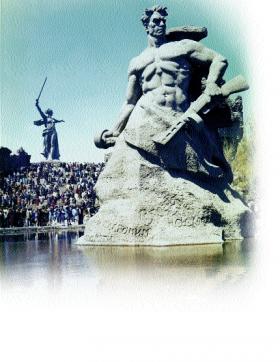
Monument to Second World War partisans on the bank of the River Volga, near Volgagrad, formerly Stalingrad. (Connolly Books)
After seven decades of ideological, political and economic confrontation, focused on Europe but extending throughout the world—and played out by proxy in Africa and elsewhere—one whole system collapsed within a few years, and by the end of 1991 the communist system had expired in Russia, the land of its birth.
Very few predicted such a turn of events, although many hoped for it and expressed wishful thinking on that score. Some, such as the dissident writer Andrei Amalrik, had even suggested that the national question might be the cause of the final break-up of the Soviet Union, although in rather different circumstances from those in which it did, in fact, challenge the system’s integrity. But the working assumption of populations, politicians and scholars alike was that the communist system was here to stay. It might modify its forms; it might become somewhat mellow as it became a wealthier society; it might even evolve into something recognisably different from the Stalinist form in which it was exported to Eastern and Central Europe after the Second World War. But the Soviet Union would survive, and that system would continue in the Soviet Union’s allies to the west.
History had demonstrated the point. Hungary 1956, Czechoslovakia 1968 and Poland 1980–1—not to mention Afghanistan after 1979—proved that: communists didn’t give up power, did they? They would lie, cheat, bluff and do anything else in order to maintain that system. The Soviet Union was an evil empire, the focus of evil in the world, as US president Ronald Reagan declared. We knew where we stood: on opposite sides of a divide that acquired moral righteousness on both sides.
For their part, the Soviet leaders themselves referred scathingly to the jungles of capitalism, and presented their system as devoid of the exploitation of man by man that Marx had said characterised capitalism. The contrast between the dynamic Soviet Union and the inflation- and unemployment-ridden Western world in the 1930s, and similar contrasts in the early 1970s, made the point eloquently (the world knew little of the cost, and was misinformed by those, such as Sidney and Beatrice Webb, who blithely reported that they had observed ‘a new civilisation’). The system opened up somewhat to outside influences, and it seemed capable of adaptation in order to survive—or, if pushed, its leaders would be prepared to clamp down. Under détente, the iron curtain had perhaps become porous, but it would remain in existence. We lived in a divided world, with two economic, political and social systems vying for supremacy and for influence in the ‘third world’. The arms race and the propaganda war seemed to reflect a permanent—or at least indefinite—state of affairs.
How wrong the world was! Whether devotees of communism or its severest opponents, everyone seemed to be taken by surprise, and there was much that needed to be explained. After all, even some Western scholars who bent over backwards to be fair to the Soviet system could not believe that Gorbachev was introducing measures that would fundamentally alter the system, let alone lead to its collapse.
Not what it seemed
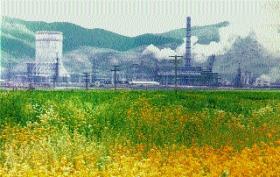
The Razdan mining and chemical combine, Armenia. Environmental pollution was virtually ignored during the Soviet era. (Novosti Photo Library, London)
In fact, although they did not predict the collapse, Western specialists clearly understood the problems of the Soviet Union. Quite apart from the periodic reminders of how brutal it could be in keeping its friends on course towards a goal that it claimed the right to identify, signs of decay were apparent from the late 1970s. Leonid Brezhnev’s finest hour was probably the Helsinki conference of July 1975, at which the Final Act formally concluded the Second World War, 30 years late. In the next few years, as the leaders grew steadily older and more complacent, with their talk of ‘developed socialism’, the system went into decline. Mikhail Gorbachev was to call this the period of ‘stagnation’—although, interestingly, surveys among citizens of the former Soviet Union reveal that to have been the most prosperous time of their lives.
But we knew that the country could not feed itself, despite its rich black soil in European Russia and Ukraine and the virgin lands of Kazakhstan, brought under the plough from the late 1950s. Industrial growth slowed down appreciably, and the economy virtually stagnated in the first year or two of the 1980s. More worryingly, the European population ceased to reproduce itself; deposits of coal, iron ore and other resources in European Russia became exhausted; and disregard for the laws of nature led to profligate and careless use of resources, which poisoned the atmosphere, ruined the Aral Sea, salinated soil, polluted rivers, and in some areas led to a virtual epidemic of genetic disorders.
Even as the population slowly accumulated material wealth—more and better clothing, consumer durables, cars—and had the chance to relax a little more, cynicism at the top permeated the whole society. As the leaders shopped in special stores, ate in special restaurants, gained privileged access to medical specialists, and awarded themselves medals for services to ‘socialism’, the population engaged in petty infringements of legality. Stealing materials from their work in order to run an illegal repair business; travelling to the capital to buy goods to sell at exorbitant prices in the provinces; spending money on vodka, turning up at work drunk, ill-treating their wives and families: these were some of the signs of a pathological society. So were the rising divorce and suicide rates and the reversal of life expectancy, which led the government to abandon plans to raise the pension age: working men and women were not living long enough to reach it! Even the question of nationality relations, declared by Brezhnev to have been ‘solved’, was later recognised to be causing disquiet.
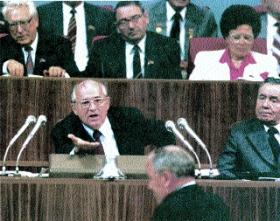
Mikhail Gorbachev came to power in March 1985 and embarked on a long-overdue shake-up of the system—he is shown here making a point at the nineteenth conference of the Communist Party of the Soviet Union (CPSU) in 1988. (Liba Taylor/Huthison )
This was a rotten society, and the rot had started at the top. Mikhail Gorbachev, soon after coming to power in March 1985, spoke of ‘a pre-crisis situation’, and embarked on a long-overdue shake-up of the system. However, the tasks proved too challenging, as attempted solutions released still more problems, snowball-fashion.
Perestroika
Gorbachev clearly understood that much was wrong, although perhaps not just how serious the situation was. He knew the system from the inside. His mentor was Brezhnev’s successor, Yuri Andropov, from whom he picked up the phrase ‘There are no ready recipes’ for solving the country’s problems.
There certainly weren’t, and over the next five years he tried different tacks to deal with problems as they arose. His first slogan, ‘acceleration of economic and social processes’, aimed to identify reserves in the economy—including the ‘reserves’ of human effort represented by workers standing in queues for bread, meat, soap and practically everything else, or drinking themselves silly for lack of anything else they wanted to spend their money on. An anti-drink campaign backfired by alienating much of the male population and leading to sugar shortages as people distilled their own.
This was followed by attempts to dismantle the ‘command–administrative’ system of the planned economy. According to that, every factory, farm, mine and industrial plant had its detailed instructions about what to produce in what quantities, where to get materials, at which outlets to sell their products and at what prices. In the absence of a market economy, the state prices committee had the task of fixing the price of 24 million individual products—which meant that responding to supply and demand was impossible. Shortages of everything were the result. Perestroika applied above all to these economic reforms, which also allowed for personal enterprise and joint ventures with foreign firms in order to introduce better management and the stimulus of competition for the state enterprises.
In the event, thanks to other reforms, compounded by lukewarm support from the West, the economy never pulled round. Inflation wiped out savings and left a legacy of bitterness that has still not been overcome: many look back to the period of ‘stagnation’ as the time they were best off; the losers of perestroika have not regained their position.
Glasnost’
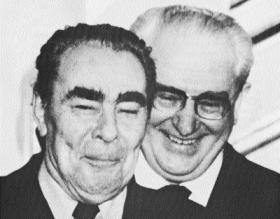
Leonid Brezhnev with his successor, Yuri Andropov, Gorbachev’s mentor. (SIPA Rex Features)
Gorbachev also shocked and alienated the apparatchiki—the party and state bureaucrats who really ran the system—by referring to the Communist Party’s ‘infallibility complex’, and engaged in a drive against corruption in the system. In this his weapon was glasnost’, ‘openness’ or ‘publicity’, which allowed the press to unmask abuse by officials at all levels in the system. Factory directors, shop managers, officials in ministries—these became targets of exposés in the party press for their illegal acts of self-enrichment. Bemused ordinary citizens began to rush out to buy the usually bland official newspapers to see which senior official was next to be exposed by Pravda.
These were stirring times, but more was to come. Censorship was relaxed, so that novels, plays and films prepared years earlier could now be presented for the first time, challenging the idea that all was best in the best of all possible Soviet worlds. It was an exciting time to be a student of Soviet affairs after decades of reading Izvestia editorials or scanning politicians’ speeches for hints of a change in line or suggestions about the pecking order in the Politburo. A particular stir was caused by the film Repentance by the Georgian director Tengiz Abuladze, but equally impressive was Little Vera (which also means ‘Little Faith’ in Russian), depicting the anomie of alienated youth in a soulless industrial city, a theme taken up also in It’s not easy to be young. Plays, novels and memoirs likewise touched on hitherto taboo subjects.
Politics, too, was opened up, and thousands of discussion groups and clubs were established under glasnost’ to debate ideas for the way forward. The literary and political journals published challenging articles and organised round-table discussions by philosophers, who earnestly debated ideas for reform. Gorbachev appointed liberal, reform-minded advisers.
Notable among these was Georgii Shakhnazarov, who in the early 1970s had published challenging books about the way forward for socialism. He had not been heeded at the time, but his ideas—and those of many other intellectuals—had been quietly circulating in manuscripts and conference papers, sometimes far from the politically sensitive capital city. It was these ideas that Gorbachev was now capitalising on.
In fact, although it took a man with Gorbachev’s vision and political authority to set the changes in motion, the thinking had already been done that both demonstrated the need for reform and indicated possible ways forward. Electoral reform had been discussed since the mid-1960s, institutional reform from the following decade; the delicate question of party–state relations had been raised in some scholarly works, and a good deal of research into the representative institutions had shown the need for reform and development of the deputy’s role as champion of the citizen.
It was a report by the sociologist Tatyana Zaslavskaya, presented at a conference in the academic city of Novosibirsk in 1983, that drew Gorbachev’s attention to the urgent need for reform. This ‘Novosibirsk Report’ identified many negative features of Soviet society, including the signs of social pathology noted above. It was quite clear to Zaslavskaya and other scholars of that age group—people who had joined the Communist Party in the period immediately after the twentieth Communist Party congress in 1956 (at which Khrushchev delivered his notorious ‘secret speech’ denouncing Stalin’s ‘personality cult’)—that the time had come for the changes they had long waited for. And in Gorbachev, himself a man of that generation, they found their champion. (Khrushchev’s secret speech was published for the first time in the Soviet Union in 1989.)
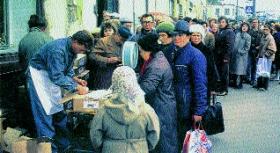
Gorbachev’s first slogan—‘acceleration of economic and social processes’—aimed to identify reserves in the economy, including the ‘reserves’ of human effort represented by workers standing in queues such as this one in Moscow for sweets. (Hjalte Tin/Still Pictures)
Resistance
In his first year or so in office, Gorbachev moved speedily and deftly to remove rivals and opponents of his policies from positions of influence, and brought in newcomers who thought as he did. These included, most significantly, Alexander Yakovlev, who had been ‘exiled’ as ambassador to Canada after publishing an article critical of Russian chauvinism. Back in Moscow, and promoted to a position of ideological influence, he developed many of the ideas that Gorbachev, as party leader and later president of the USSR, took up. Yakovlev has, indeed, been called the ‘father’ of perestroika.
But in challenging some of the traditional elements of communist rule, Gorbachev was taking a great risk. He could not simply dismantle the old system and replace it with another. Society had to be kept running, and that depended on the knowledge, skills and experience of the people in the apparatus whose security had been guaranteed by Brezhnev. As on previous occasions, they were provoked, and were prepared to resist, even if that meant infringing Communist Party discipline. Their champion was Yegor Ligachev, a Politburo member who represented the more traditional communist approach, on Gorbachev’s right. To his left was, among others, Boris Yeltsin, who within a year or two became Gorbachev’s nemesis.
When, in March 1988, an article appeared in the newspaper Sovetskaya Rossiya, written by a Leningrad chemistry lecturer by the name of Nina Andreeva, Ligachev was widely believed to have sanctioned publication. Entitled ‘I cannot forgo my principles’, the article was a cri de coeur from an old Stalinist, who accused the ‘liberals’ of
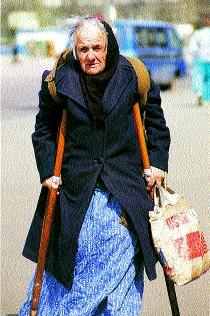
A Russian ‘bag lady’—one of the growing number of elderly women and men living on the streets in Moscow by the mid-1990s. (Jim Holmes)
denigrating the achievements of the Soviet Union, specifically under Stalin, and selling out to the West, the traditional enemy. The rot had set in, according to the author, under Khrushchev, who had supposedly abandoned the values and the discipline that had encouraged millions of citizens of her generation to build a new society. Anti-Semitism featured in her rant—yet she spoke for millions who felt their life was being destroyed. Their efforts to build an industrial society in the 1930s; their suffering in the Second World War; their renewed efforts to reconstruct the devastated economy; their support for the oppressed millions in the colonies—all this was being treated as worthless by Westernising politicians who were now ready to destroy the system that had achieved all this. She naturally ignored the terror as she called for a reversion to a Soviet Union of before the twentieth party congress.
By the time of its nineteenth conference in June 1988 the Party seemed bitterly divided, and Gorbachev manifestly failed to win the support of the apparatchiki for perestroika. To get round that, democratisation was Gorbachev’s prescription.
Democratisation
Pushed into confrontation by the resistance of those whose power derived from their occupancy of positions of authority to which they were appointed without being answerable to the public, Gorbachev announced contested elections and a restructuring of the institutional framework to create a genuinely representative parliament with real law-making powers. It was a bold move, but ultimately it unleashed forces that could not be controlled. Or, rather, it gave power to forces that had been simmering below the surface. In trying to lead from the centre, Gorbachev found it necessary to tack to left and right, and to accumulate more and more power, so as to bypass the traditional locus of authority, the Communist Party central apparatus. The creation of a strong presidency in the spring of 1990 was part of this, and that new office gradually expanded its powers, to the extent that even supporters eventually suggested that, in simultaneously holding that position, the post of party general secretary, chairman of the defence council and other demanding offices, Gorbachev was risking overload; the system that depended so closely on the stamina and judgement of one man might be placed in jeopardy. Democracy from below challenged attempts by Gorbachev and the Centre to retain control, and the president fought an increasingly fraught battle on several fronts to push ahead the changes that he believed might save the system.
As the Centre lost its capacity to force compliance with its own laws, the performance of the economy spiralled downwards. Shortages of most everyday items—including, notoriously, soap in the mining cities of the Donbass—led to strikes and protests, which further exacerbated the dismal performance. Gorbachev failed to win the financial support of the West when he attended a G7 meeting in the early summer of 1991. By that stage, still further factors were threatening the stability of the system, notably stirrings among the minority populations.
The nationalities
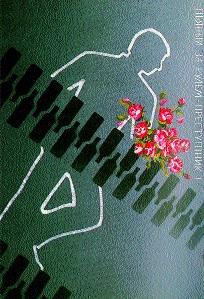
‘A drunk behind the wheel is a criminal’—Gorbachev era poster from the campaign against drunkenness and alcoholism. The campaign backfired by alienating much of the male population and leading to sugar shortages as people distilled their own alcohol. (Novosti Photo Library, London)
Gorbachev’s policies, in opening up the field of political debate and action, rendered dissidence a meaningless concept (the dissident physicist Andrei Sakharov had been allowed to return to Moscow from internal exile in December 1986), and all manner of alternative ideas to those of traditional communism or even socialism emerged. Among the Soviet Union’s 100-plus nationalities, at least some of whom had been forcibly incorporated into Czarist Russia or later into the Soviet Union, and others of whom had been abominably treated by both regimes, saw the opportunities offered by glasnost’ and democratisation. Led by Lithuania, but followed by movements in Ukraine, Moldova, Georgia and elsewhere, whole nations from 1988 declared their ambition to secede from the Union, and set up independence movements to achieve that aim.
Sajudis in Lithuania, Rukh in Ukraine, and other separatist movements challenged the institutions of the Centre, and attracted such popular support that in some republics the Communist Party had to split with Moscow or face political defeat once real elections gave the people a voice. The Communist Party reluctantly surrendered its political monopoly in early 1990, and newly elected parliamentary institutions quickly challenged the authority of the Centre by declaring their sovereignty, annulling Soviet laws and the decrees of the Soviet president and Communist Party in what became a ‘war of laws’. Ancient grievances—such as that of Armenia over the treatment of co-nationals in the enclave of Nagorny Karabakh inside neighbouring Azerbaijan—spilled over from protest to warfare, and the central authorities’ heavy-handed response fuelled the fires of separatism. Incidents in Georgia and Lithuania added to the build-up of tension and resentments against the Centre.
A referendum on 17 March 1991, aimed at gauging opinion on a proposal to refashion the USSR into a different—non-Soviet—entity, was boycotted in some areas, and elsewhere applied with different wording, or with additional questions. In the Russian republic, voters endorsed the creation of a presidency, to which Boris Yeltsin was elected by a landslide in June.
Meanwhile, the Communist Party itself haemorrhaged members, who no longer saw any advantage in belonging to an institution that was losing authority and power. Indeed, the party was in steep decline as it refused to countenance the serious reform demanded by its leader, Mikhail Gorbachev. Boris Yeltsin ostentatiously resigned his membership, striding purposefully from the platform of the party’s twenty-eighth congress in July 1990, in effect turning his back on Gorbachev and all attempts to rescue the system.
Yeltsin versus Gorbachev
Yeltsin’s subsequent political rise was swift, and he worked steadily to undermine Gorbachev and the system that he himself had used in his route to high office, deploying his authority as elected leader of the largest republic in the Soviet Union. In that capacity, he urged the leaders of other territorial units inside Russia to take as much sovereignty as they could swallow—an invitation to challenge the authority of the Centre.
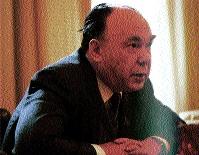
Aleksandr Yakovlev, one of the newcomers brought in by Gorbachev. Previously he had been ‘exiled’ as ambassador to Canada after publishing an article critical of Russian chauvinism. (Novosti Photo Library, London)
Negotiations on a new Union Treaty produced a draft that was to be signed by the Centre and representatives of most of the existing republics on 20 August 1991. Two days before that, however, hardliners among Gorbachev’s own team—including his vice-president and prime minister—staged a coup against the president, on vacation at his government holiday home in the Crimea. The coup collapsed in a couple of days, but Gorbachev returned to Moscow in thrall to Boris Yeltsin, whose nimble political footwork and considerable personal bravery in the days of the attempted coup, on top of his electoral mandate, gave him the political authority that Gorbachev lacked.
Within days he had banned the Communist Party from functioning inside Russia; over the autumn he contradicted the central government’s edicts and laws with edicts of his own, effectively rendering it impossible for the Centre to function over the bulk of the USSR’s territory. On 1 December the citizens of Ukraine voted in a new referendum for independence; the presidents of Russia, Ukraine and Belorussia met in a forest lodge outside Minsk and announced the establishment of a Commonwealth of Independent States, to replace the Soviet Union.
For Gorbachev the game was up. In a televised address, he urged the Supreme Soviet to dissolve the USSR, which it duly did, and the colossus that had embraced one-sixth of the Earth’s land surface ceased to exist. In its place, fifteen newly independent states set out to find their way in a world that had changed remarkably during the Soviet Union’s existence. Some are finding the Soviet experience very hard to overcome, but few mourn the passing of a brutal, if in some ways progressive, regime. It had lost its way sometime in the 1970s, and the events of 1985–91 proved it to be irredeemable.
Ron Hill is Professor of Comparative Government in Trinity College, Dublin.
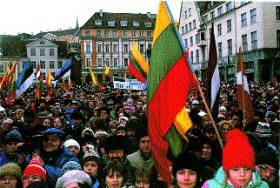
Nationalist demonstration in Estonia, February 1989—the Baltic states led the way in moves to secede from the Soviet Union. (Frank Spooner Pictures)
Further reading:
A. Brown, The Gorbachev factor (Basingstoke, 1996).
M. Gorbachev, Memoirs (London, 1997).
R. Walker, Six years that shook the world: Perestroika—the impossible project (Manchester, 1993).
S. White, Communism and its collapse (London, 2000).
This article is relevant to the ‘collapse of Soviet Union’ element of topic 4 (‘Division and realignment in Europe, 1945–1992’) of the later modern Europe and the wider world field of study (1815–1992) of the Southern Leaving Certificate syllabus, and to module 5, option 5 (‘The clash of ideologies in Europe 1900–2000’), of the Northern history A-level syllabus.
















